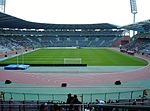Heysel Stadium disaster
The Heysel Stadium disaster (Italian: Strage dell'Heysel [ˈstraʤe ˈdel ˈhaɪzl̩]; German: Katastrophe von Heysel [ˈhaɪzl̩]; French: Drame du Heysel [ɛzɛl]; Dutch: Heizeldrama [ˈɦɛizəlˌdraːmaː]) was a crowd disaster that occurred on 29 May 1985 when mostly Juventus fans escaping from a breach by Liverpool fans were pressed against a collapsing wall in the Heysel Stadium in Brussels, Belgium, before the start of the 1985 European Cup Final between the Italian and English clubs. 39 people—mostly Italians and Juventus fans—were killed and 600 were injured in the confrontation.Approximately an hour before the Juventus–Liverpool final was due to kick off, Liverpool supporters charged at Juventus supporters and breached a fence that was separating them from a "neutral area". The cause of the rampage has been attributed by eyewitnesses to Liverpool fans who had been drinking heavily. Juventus fans ran back on the terraces and away from the threat into a concrete wall. Fans already standing near the wall were crushed; eventually the wall collapsed, allowing others to escape. Many people climbed over to safety, but many others died or were badly injured. The game was played despite the pre-match incidents by authorities and organizers' joint decision for public policy doctrine reasons after being declared a state of siege in the city, with Juventus winning 1–0.The tragedy resulted in all English football clubs being placed under an indefinite ban by Union of European Football Associations (UEFA) from all European competitions (lifted in 1990–91), with Liverpool being excluded for an additional two years, later reduced to one, and fourteen Liverpool fans found guilty of manslaughter and each sentenced to six years' imprisonment. The disaster was later described as "the darkest hour in the history of the UEFA competitions".
Excerpt from the Wikipedia article Heysel Stadium disaster (License: CC BY-SA 3.0, Authors).Heysel Stadium disaster
Avenue de Marathon - Marathonlaan, City of Brussels
Geographical coordinates (GPS) Address Nearby Places Show on map
Geographical coordinates (GPS)
| Latitude | Longitude |
|---|---|
| N 50.895 ° | E 4.3338888888889 ° |
Address
Stade Roi Baudouin - Koning Boudewijnstadion
Avenue de Marathon - Marathonlaan 135
1020 City of Brussels
Belgium
Open on Google Maps









